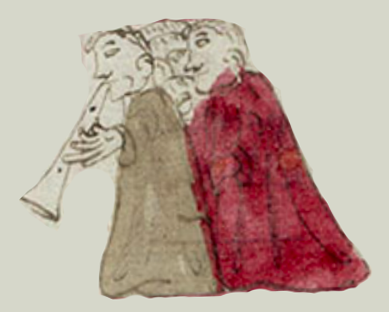teopan nenque (CST27)
This painting of the simplex glyph for the term teopan nenque (people who live or work at the church) These are typically indigenous men. Diego Muñoz Camargo’s Historia de Tlaxcala, he refers to them variously as regidores, sacerdotes, or religiosos “de aquella religión” (of that, i.e., Nahua, religion). The glyph shows two standing men in profile, apparently walking toward the viewer’s left. The one in front wears a light-brown robe, and the one in back wears a red robe. Their skin is white. The one in front is playing a straight, horned instrument (perhaps a chirimía), but only his left hand is visible. The one in back is very close behind. Between their two heads is a drawing of something that is difficult to discern.
Stephanie Wood
Indigenous church people, such as shown here, have a name that could point to pre-contact practices, but teopan nenqui could also be a neologism. Friars such as Gante, Olmos, Motolinia and others of the Colegio de Santa Cruz Tlatelolco began drawing Nahuas into the church, teaching them to be singers (cantores) and more. (See Fernando Horcasitas, Teatro Náhuatl, 2004, 173.) Louis Burkhart notes how cantores came from the local nobility, and Spaniards tried to limit their numbers. Cantores could provide instrumental music and sing, and sometimes they put on plays. (See: Aztecs on Stage, 2012, 23.)
Stephanie Wood
1550–1564
Jeff Haskett-Wood
glesias, cantores, músicos, instrumentos musicales, fiscales

teopan nemi, a church person or one who lives at the temple or church, https://nahuatl.wired-humanities.org/content/teopan-nemi
teopan, temple or church, https://nahuatl.wired-humanities.org/content/teopan
nemi, to live or dwell, https://nahuatl.wired-humanities.org/content/nemi
nenqui, one who lives or is a resident, https://nahuatl.wired-humanities.org/content/nenqui
gente de la iglesia
Stephanie Wood
Códice Sierra-Texupan, plate 27, page dated 1559. Origin: Santa Catalina Texupan, Mixteca Alta, State of Oaxaca. Kevin Terraciano has published an outstanding study of this manuscript (Codex Sierra, 2021), and in his book he refers to alphabetic and “pictorial” writing, not hieroglyphic writing. We are still counting some of the imagery from this source as hieroglyphic writing, but we are also including examples of “iconography” where the images verge on European style illustrations or scenes showing activities. We have this iconography category so that such images can be fruitfully compared with hieroglyphs. Hieroglyphic writing was evolving as a result of the influence of European illustrations, and even alphabetic writing impacted it.
https://bidilaf.buap.mx/objeto.xql?id=48281&busqueda=Texupan&action=search
The Biblioteca Digital Lafragua of the Biblioteca Histórica José María Lafragua in Puebla, Mexico, publishes this Códice Sierra-Texupan, 1550–1564 (62pp., 30.7 x 21.8 cm.), referring to it as being in the “Public Domain.” This image is published here under a Creative Commons license, asking that you cite the Biblioteca Digital Lafragua and this Visual Lexicon of Aztec Hieroglyphs.








